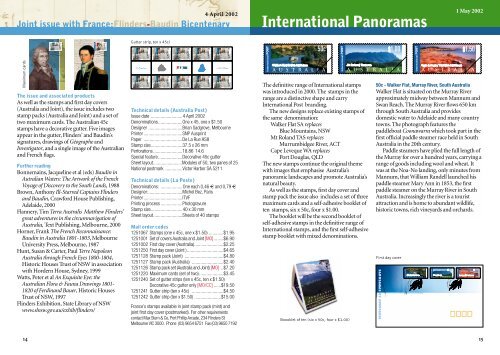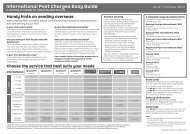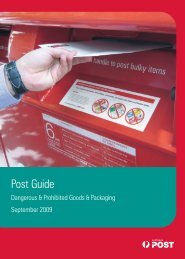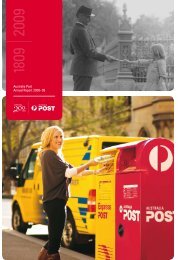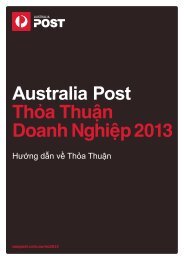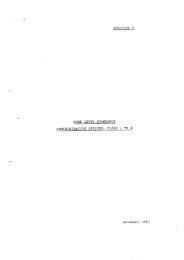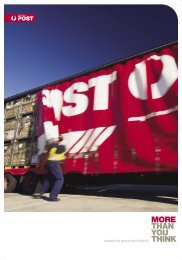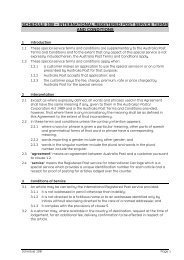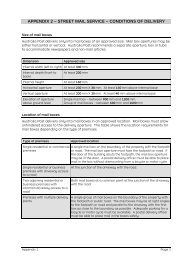Download - Australia Post Shop
Download - Australia Post Shop
Download - Australia Post Shop
Create successful ePaper yourself
Turn your PDF publications into a flip-book with our unique Google optimized e-Paper software.
The first <strong>Australia</strong>n<br />
Grand Prix was held<br />
at Cowes, Phillip<br />
Island in 1928 as the<br />
100-Mile Road Race.<br />
Bob Jane’s distinctive,<br />
modified white Jaguar<br />
Mark II won the<br />
<strong>Australia</strong>n Touring<br />
Car Championship<br />
in 1962 and 1963.<br />
When Brabham won<br />
the 1966 World<br />
Formula One Driver’s<br />
Championship he<br />
became the first person<br />
to win it driving a car<br />
built in his own factory.<br />
Technical details<br />
Issue date......................27 February 2002<br />
Denominations ..............Six x 45c<br />
Illustrator ......................Fredd Briggs, Melbourne<br />
Designer ......................Belinda Marshall, <strong>Australia</strong> <strong>Post</strong><br />
Design Studio<br />
Stamp size (all) ..............37.5 x 26 mm<br />
Perforations ..................13.86 x 14.6<br />
Printer (all) ....................SNP Ausprint<br />
Paper (gummed) ............Tullis Russell<br />
Paper (self-adhesive) ....booklets JAC B100<br />
....rolls JAC B90<br />
Sheet layout ..................Modules of 50, two panes of 25<br />
Special features ............Racing flags printed in gutter<br />
National postmark..........Albert Park VIC 3206<br />
8<br />
Maximum cards<br />
For much of its history,<br />
the Bathurst event has<br />
been regarded as a<br />
Ford versus Holden<br />
competition.<br />
Alan Jones was the<br />
second <strong>Australia</strong>n to<br />
win the World<br />
Championship.<br />
The Formula One World<br />
Drivers’ Championship<br />
begins each year with the<br />
<strong>Australia</strong>n Grand Prix at<br />
Albert Park, Victoria.<br />
Mail order codes<br />
1249067 Stamps ‡ (se-tenant block of six x 45c) ....$2.70<br />
1249182 Booklet of ten x 45c ..............................$4.50<br />
1249209 Roll of 100 x 45c ................................$45.00<br />
1249200 Strip of six x 45c from roll........................$2.70<br />
1249261 Cheque book of 20 booklets of ten x 45c ....$90.00<br />
1249001 Set of two first day covers (gummed,<br />
self-adhesive) [MO/CC] ..........................$6.00<br />
1249002 First day cover (gummed) ......................$3.00<br />
1249003 First day cover (self-adhesive) ................$3.00<br />
1249126 Stamp pack ..........................................$3.15<br />
1249223 Collector pack [MO/CC]..........................$7.20<br />
1249220 Maximum cards (set of six) ....................$7.20<br />
1249240 Gutter strip (ten x 45c)<br />
racing flags printed in gutter ..................$4.50<br />
1249219 Book: <strong>Australia</strong>n Motor Racing:100 years$17.50<br />
‡ <strong>Australia</strong>n Philatelic Bureau will supply blocks of six<br />
stamps in the standard block (see page 6) or corners.<br />
Lighthouses<br />
The need for lighthouses is ancient and<br />
practical. Some three thousand years ago<br />
wood-burning beacons were used to guide<br />
vessels safely to harbour.<br />
Through the ages wood was replaced by coal<br />
and oil. The smokeless oil lamp was a great<br />
improvement. Then reflective surfaces were<br />
used to increase the power of the lights.<br />
Later rotating lights and reflectors which<br />
enabled each lighthouse to produce a unique<br />
signal were a boon to navigation.<br />
When lenses and prisms were added the<br />
lighthouses produced a more tightly focused<br />
beam of light which improved the visibility of a<br />
lighthouse’s light.<br />
Architecture and building techniques were<br />
also advancing. New designs and methods<br />
made it easier and more economical to build in<br />
the often treacherous conditions where the<br />
lighthouses were needed.<br />
At the end of the 19th century the art and<br />
industry of lighthouse construction reached its<br />
peak. Since then efforts have concentrated on<br />
reducing costs.<br />
12 March 2002<br />
In <strong>Australia</strong> building lighthouses was first<br />
undertaken by each colony when funds were<br />
available. The Commonwealth Lighthouse<br />
Service began in 1915 with a stock of 179<br />
marine marks, including 104 manned stations.<br />
From 1913 there was a growing emphasis on<br />
unmanned stations with automatic lights.<br />
Today there are some 400 light stations<br />
around <strong>Australia</strong>. They are maintained by the<br />
<strong>Australia</strong>n Maritime Safety Authority (AMSA)<br />
and State authorities. The occupation of<br />
lighthouse keeper has passed into history. All of<br />
<strong>Australia</strong>’s lighthouses have been converted to<br />
automatic lights, some have had their roles<br />
usurped by newer structures. The traditional<br />
stone towers are all heritage listed and many<br />
have become tourist attractions.<br />
Today lighthouses and vessels use modern<br />
technology to prevent the loss of lives and cargo<br />
on reefs, rocks and otherwise dangerous shores.<br />
But something about a lighthouse lives on in<br />
spite of conversions or decommissioning and<br />
the loss of the romantic image of the solitary<br />
keeper. The allure of these magnificent guiding<br />
lights is timeless and universal.<br />
9


